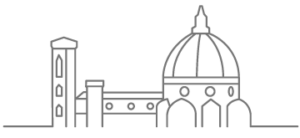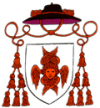The oldest monument in the square is the Baptistery of San Giovanni, which for many centuries was considered a pagan temple "converted" for Christian use. In fact, already at the end of antiquity - in the fifth or perhaps sixth century - a primitive baptistery was built here in front of Santa Reparata, the then cathedral, in a spatial relationship similar to what we see today. This first baptistery had to be similar to the present one also in the octagonal form symbolizing "l 'octava dies", "the eighth day" - the time of the Risen Christ, out of our time marked in units of seven days. This symbolism refers directly to Baptism, the sacrament of initiation into the Christian faith, whereby believers pass from the death of sin to new life in Christ, an "eighth day" without sunset. The octagonal shape alludes to the Christian hope of a resurrection of the dead, and must have held particular eloquence when the structure was still surrounded by a cemetery.

Starting from the middle of the 1300th century, the Baptistery was rebuilt in its present size and enriched with precious marbles, many of which came from ancient buildings. It was the period of the economic and political affirmation of the city, which first saw the transfer to Florence of the seat of the imperial government in Tuscany and, then, the autonomy of Florence from the Holy Roman Empire. In the 1500th and 1330th centuries the new structure, enlarged with the addition of the monumental dome and the "scarsella" (the rectangular apse to the west), became a source of pride for the city: Dante calls it his "beautiful San Giovanni". From 1402 to 1425 the sculptural works for which the Baptistery is famous were placed: the three bronze doors and the bronze and marble groups above the doors: works that, overall, illustrate the biblical stories that the baptized person is invited to meditate in order to live well his faith. The oldest of the doors is the one now to the south, depicting the life of San Giovanni Battista, owner of the Baptistery and patron saint of the city: the work of Andrea Pisano in the 1425s. The one to the north follows, executed by Lorenzo Ghiberti between 1450 and XNUMX. , with scenes from the life of Christ. Finally, the "door of Paradise" (as Michelangelo called it), to the east, with scenes from the Old Testament, modeled and cast by Ghiberti from XNUMX to XNUMX (now replaced by a copy).

Porta di Andrea Pisano (door to the south)
with scenes from the life of St. John the Baptist
1) Announcement of the angel to Zacharias
2) Zacharias becoming mute
3) Visitation
4) Birth of the Baptist
5) Zacharias writing the name
6) Saint John as a child in the desert
7) Preach to the Pharisees
8) Proclamation of Christ
9) Baptism of followers
10) Baptism of Jesus
11) Saint John rebukes Herod
12) Imprisonment of San Giovanni
13) Visit of the disciples
14) Visit of the disciples to Jesus
15) Dance of Salome
16) Beheading of St. John the Baptist
17) Presentation of the head to Herod
18) Salome brings her head to Herodias
19) Transport of the body
20) Burial
A) Hope
B) Faith
C) Charity
D) Humility
E) Fortress
F) Temperance
G) Justice
H) Prudence.
Porta di Lorenzo Ghiberti (door to the north)
with scenes from the New Testament.
1) Annunciation
2) Nativity
3) Adoration of the Magi
4) Dispute with doctors
5) Baptism
6) Temptation
7) Expulsion of the merchants from the temple
8) Jesus walking on the water and saving Peter
9) Transfiguration
10) Resurrection of Lazarus
11) Entry of Jesus into Jerusalem
12) Last supper
13) Prayer in the garden
14) Capture of Christ
15) Flagellation
16) Jesus before Pilate
17) Ascent to Calvary
18) Crucifixion
19) Resurrection
20) Pentecost
A) Saint John the Evangelist
B) St. Matthew
C) San Luca
D) San Marco
E) Sant'Ambrogio
F) San Gerolamo
G) San Gregorio
H) Saint Augustine.
"Gate of Paradise" by Lorenzo Ghiberti (east door)
with scenes from the Old Testament.
Stories by:
1) Adam and Eve
2) Cain and Abel
3) Noah
4) Abraham
5) Isaac and his sons, Esau and Jacob
6) Joseph
7) Moses
8) Joshua
9) David
10) Solomon and the Queen of Sheba.





